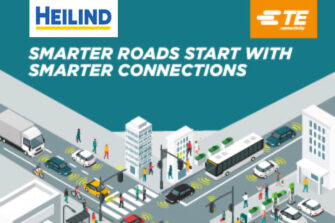By Aatish Hundia, Director Hundia Infosolutions Pvt. Ltd. (EVM India)
India has made decisive strides on road safety—dual airbags, speed alerts, ABS, and the launch of Bharat NCAP have all raised the bar. Yet the country still bears a disproportionate share of the world’s road fatalities: with roughly 1% of the world’s vehicles, India accounts for about 10–11% of global crash deaths. The socio-economic drag is enormous, with studies estimating the cost of road crashes at around 3.14% of GDP. Those are not just statistics; they are a mandate for new tools that prevent incidents, resolve disputes quickly, and reward safe driving. Dashcams fit that brief perfectly. They should be treated as essential safety equipment—the next seatbelt for Indian roads.
From“gadget” to safety infrastructure
A dashcam is not a toy for enthusiasts; it’s a neutral witness. In a country where CCTV coverage is patchy and collisions often devolve into “he said, she said,” high-quality, tamper-resistant video transforms how police and insurers establish facts. This single shift can shorten claims cycles, curb fraud, and de-incentivise dangerous behaviours such as tailgating, lane cutting, and hit-and-run. Over time, the presence of dashcams changes social norms on the road the way seatbelts did two decades ago.
Bharat NCAP gives consumers a clear star-rating for crashworthiness. A complementary “evidence layer” from dashcams would strengthen the post-crash ecosystem—speeding up justice, improving claims outcomes, and creating a feedback loop for safer roads.
India-first design: heat, dust, monsoon—and two-wheelers
India’s road reality is unique: extreme heat, dust, vibration, sudden glare, monsoon downpours, chaotic traffic mixes, and a very high share of two-wheelers. The next wave of India-first dashcams should therefore prioritise:
- Thermal resilience & robust power protection for cabins that routinely touch 60°C+ in summer.
- Low-light and night-glare optimisation for unlit highways and rain-soaked city nights.
- High-reliability storage to sustain continuous recording and protect footage during power loss.
- Two-wheeler form factors (helmet/handlebar mounts with stabilization and rainproofing), since riders are among the most vulnerable users on Indian roads.
These are not nice-to-haves; they are the difference between a camera that “works in a lab” and one that delivers justice on the Eastern Express Highway in peak monsoon.
The hidden backbone: storage at the edge
Dashcams sit at the intersection of optics, AI, and—critically—storage. As vehicles become rolling computers, onboard storage needs are exploding. Industry analyses indicate cars will require 2–11 TB of storage over the coming decade, driven by advanced infotainment, telematics, ADAS, and continuous sensor capture. While full autonomy is still some distance away for India, even today’s use-cases—loop recording, event tagging, 24×7 parking mode—demand automotive-grade storage built for constant write endurance and data integrity. This is a Make-in-India opportunity across NAND, controllers, and ruggedized storage modules, tightly integrated with device firmware.
Insurance, fleets, and MSMEs: the immediate ROI
If consumers see dashcams as “peace of mind,” fleets see them as P&L levers. For logistics operators, ride-hail platforms, school buses and staff transports, dashcams enable:
- Faster, fairer claims with irrefutable evidence;
- Driver coaching via AI-detected harsh braking, tailgating, or distraction;
- Theft and pilferage deterrence through visible recording and incident alerts;
- Operational analytics that reduce downtime and improve route discipline.
For insurers, verified footage and crash telemetry can curb fraud and support usage-based discounts—turning underwriting from punitive to preventive. Aligning incentives here is how you scale adoption quickly and fairly.
Privacy by design in the DPDP era
Any technology that records people must earn trust. India’s Digital Personal Data Protection Act (2023) sets clear principles around consent, data minimisation, purpose limitation, and children’s data. Responsible dashcam ecosystems should therefore prioritise on-device processing, encryption at rest and in transit, short, transparent retention windows, opt-in cloud back-ups, and privacy-aware sharing (for example, automatic face and number-plate blurring for publicly shared clips). Done right, privacy is not a blocker—it’s a competitive advantage that separates serious, compliant players from grey-market imports.
What government and regulators can do—now
India has a long track record of using standards and nudges to move markets. A targeted, time-bound roadmap can make dashcams ubiquitous without burdening consumers.
- Recognise dashcams as safety equipment. Issue an advisory classifying certified dashcams as safety devices, opening the door to GST rationalisation and OEM fitment options.
- Create a voluntary BIS/AIS specification. Start with thermal safety, EMC, wiring, battery protection (for models with internal cells), firmware integrity/signing, and basic cybersecurity baselines—aligned to AIS-145’s safety intent and complementary to Bharat NCAP’s consumer-safety push. Devices meeting the spec could carry an “India Safety Camera” mark.
- Incentivise insurance linkages. In consultation with IRDAI and insurers, enable premium discounts for vehicles with certified dashcams and opted-in safe-driving analytics, similar to global telematics programmes.
- Fleet-first mandate. Phase 1 (next 12 months): mandate dashcams for selected commercial categories (inter-city buses, school buses, dangerous goods, and fleet taxis), alongside driver-monitoring features where appropriate. Provide soft-credit support for MSME fleets.
- Public procurement push. Equip government fleets and police patrol vehicles with dashcams—both as a signal and as a practical enforcement tool.
- Two-wheeler pilots with states. Partner with high-incidence states to trial low-cost, rugged, tamper-resistant rider cams on accident-prone corridors, measuring impact on dispute resolution and rider behaviour.
A catalyst for safer roads—and a sunrise Indian industry
Global demand is rising: the dashboard-camera market is estimated at about $4 billion (2023) with high-single-digit growth through 2030. As India formalises standards and incentives, domestic manufacturing can compete not just on cost but on contextual innovation—heat resilience, monsoon-grade optics, and privacy-by-design software. That’s exportable IP to Southeast Asia, Africa, and LATAM—regions that share India’s climate, traffic mix, and infrastructure constraints.
Seatbelts and airbags save lives during a crash. Dashcams can help prevent crashes, resolve them fairly when they occur, and reinforce safer behaviour every day. Treating dashcams as essential safety equipment is not about adding another gadget to the dashboard; it’s about adding accountability to the road.
If government lays down a voluntary standard, insurers reward adoption, and OEMs offer certified factory-fit options—while Indian brands build privacy-secure, climate-tough, storage-reliable devices—we can bend India’s crash curve faster. The technology is ready. The economics make sense. What’s needed now is intent and orchestration.
Make the next seatbelt visible. Put a witness on every windshield. It’s time.











